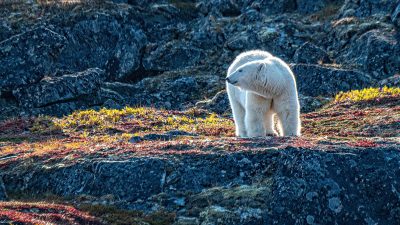Video | Destinations
Top of the World: The Secret Nazi Weather Station
By Adventure Canada | September 09, 2022
Related expedition: Greenland & Wild Labrador: A Torngat Mountains Adventure
Video | Destinations
By Adventure Canada | September 09, 2022
Related expedition: Greenland & Wild Labrador: A Torngat Mountains Adventure
Did you know that Germany had a military presence in North America at the height of the Second World War?
It was far from a full-blown invasion, but in 1943, German forces of the Nazi regime did set foot on what is now Canadian soil, on the rugged coast of Labrador. At the time, Newfoundland and Labrador were still a British Dominion. They only became a province in 1949. But they were definitely not interested in an alliance with Germany!
Germany, however, was interested in Labrador—specifically, its weather. German U-boats were tasked with sinking enemy war and supply ships in the North Atlantic Ocean. They knew that these battles were dependent on the weather.
In order for them to gain any advantage that they could, both German and Allied forces set up weather balloons and stations all over the North Atlantic. But weather systems over the North Atlantic primarily move from west to east. This gave the Allies—who had control over North America, Greenland, and Iceland—a massive advantage over the Germans.
German forces set up special remotely operating weather stations known as Wetter-Funkgerät Land, or WFL, in Greenland and Russia. Fortunately, these weather stations didn't last long and were quickly destroyed or dismantled, which created massive problems for the Germans at sea. But the weather station that did last was set up in northern Labrador.
A crew left Germany in September of 1943 in a submarine, U-537. They carried a prefabricated weather station code named K-U-R-T, or Kurt. They travelled for over a month across the Atlantic until they reached the treacherous shores of Labrador.
Eventually reaching Martin Bay on October 22, 1943, they anchored. The crew then transferred all the weather station materials from the U-boat to a rubber dinghy and travelled to the shore. There, they set up Kurt, 365 metres inland on a fifty-three-metre high hill. Over the course of twenty-eight hours, the weather station was set up while the rest of the crew on the boat was on the lookout for any passers-by, including local Inuit.
You'd think a weather station would be easy enough to spot, but Labrador is big and sparsely populated. The equipment was small and the Germans truly hid it in plain sight. They left the equipment in place, labelled with stencils that read "Canadian Meteor Service." The U-boat crew even littered the area with American cigarette packages.
Luckily, Kurt never played much of a role in the weather wars. It broadcast weather patterns for about two months until it mysteriously stopped working. But the weather station remained largely unknown until 1977. That's thirty-four years!
It was finally discovered by a geomorphologist, who was researching the area for a completely unrelated reason. And the German ploy lasted even longer. Until 1981, researchers had no idea the weather station belonged to Nazi Germany. It wasn't until an author was researching a book about Nazi weather stations that it was finally all put together.
To this day, the weather station in Labrador remains the only known German military activity on mainland North America—a long-lost story of the Second World War.

September 17 to October 1, 2025
From $9,495 to $19,095 USD
per person based on double occupancy
Save 15%

September 27 to October 11, 2026
From $15,995 to $24,195 USD
per person based on double occupancy

August 28 to September 11, 2026
From $11,995 to $22,795 USD
per person based on double occupancy